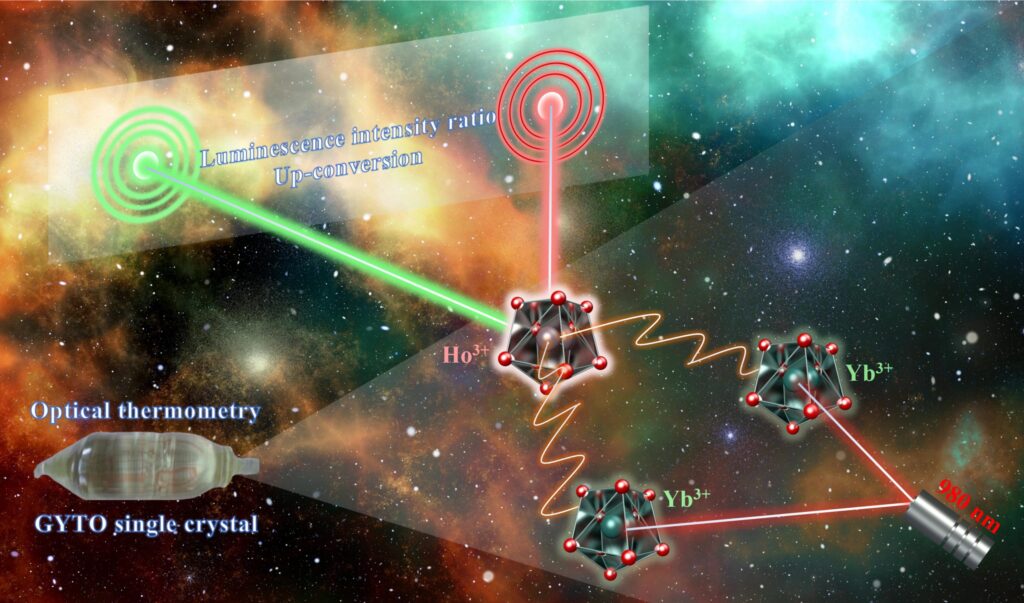Above is a graphic displaying optical thermometry based on LIR of Yb,Ho:GYTO single crystal. Credit: Chuancheng Zhang, Shoujun Ding, Miaomiao Wang, Hao Ren, Xubing Tang, Yong Zou, Renqin Dou & Wenpeng Liu
Optical thermometry utilizing upconversion (UC) luminescence from lanthanides offers both high sensitivity and swift response times. This technique is grounded in the principle of UC luminescence, a process where low-energy photons (in the near-infrared, NIR spectrum) are transformed into high-energy photons (in the visible spectrum) via the anti-Stokes mechanism.
Firstly, the Yb3+ ions absorb low energy photon with wavelength about 980 nm, then Yb3+ ions could effectively transfer energy to Ho3+ ions due to the energy levels matching between Yb3+ ions and Ho3+ ions, while the Ho3+ ion accepts the energy from two different Yb3+ ions, it is able to emit one photon with wavelength of 550 or 650 nm, and the intensity ratio of these two emission bands is called luminescence intensity ratio (LIR). The optical thermometry is realized by the alternation of LIR with temperature changing. This way, the temperature can be deduced by certain LIR.
Advancements in Optical Thermometry
Researchers led by Prof. Shoujun Ding at Anhui University of Technology (AHUT), China, are interested in optical thermometry with single crystal, the traditional LIR technique relies on detecting the thermally coupled two energy levels such as Er3+ (2H11/2, 3S3/2) and Tm3+ (3F2,3, 3H4) which are limited by the energy gaps between these pairs of levels, but in Ho3+ ions, the non-thermally coupled energy levels (5F4/5S2 and 5F5) with energy gap of 3000 cm–1 allow higher sensitivity.
The non-contact thermometry technique based on LIR enables the realization of temperature measurement in certain harsh conditions such as intracellular, coalmines and power stations. The single crystal Gd0.74Y0.2TaO4 is selected to hold Yb3+ ions and Ho3+ ions instead of traditional phosphors, this crystal owns low symmetry and strong crystal field, which is conducive to enhancing the photoluminescence efficiency of Re ions. The maximum Sa and Sr value of this new single crystal achieved 0.0010 and 0.0037 K–1, respectively. The researchers predict the significant potential of Yb,Ho:GYTO single crystal for applications in optical thermometry.
Reference: “Upconversion luminescence and optical thermometry behaviors of Yb3+ and Ho3+ co-doped GYTO crystal” by Chuancheng Zhang, Shoujun Ding, Miaomiao Wang, Hao Ren, Xubing Tang, Yong Zou, Renqin Dou and Wenpeng Liu, 31 October 2023, Frontiers of Optoelectronics.
DOI: 10.1007/s12200-023-00083-2
The study was funded by the National Natural Science Foundation of China, the Open Project of Advanced Laser Technology Laboratory of Anhui Province, Major Science and Technology of Anhui Province, the University Natural Science Research Project of Anhui Province, the Natural Science Foundation of Tianjin, and the Chongqing Key Laboratory for Advanced Materials and Technologies of Clean Energy.


